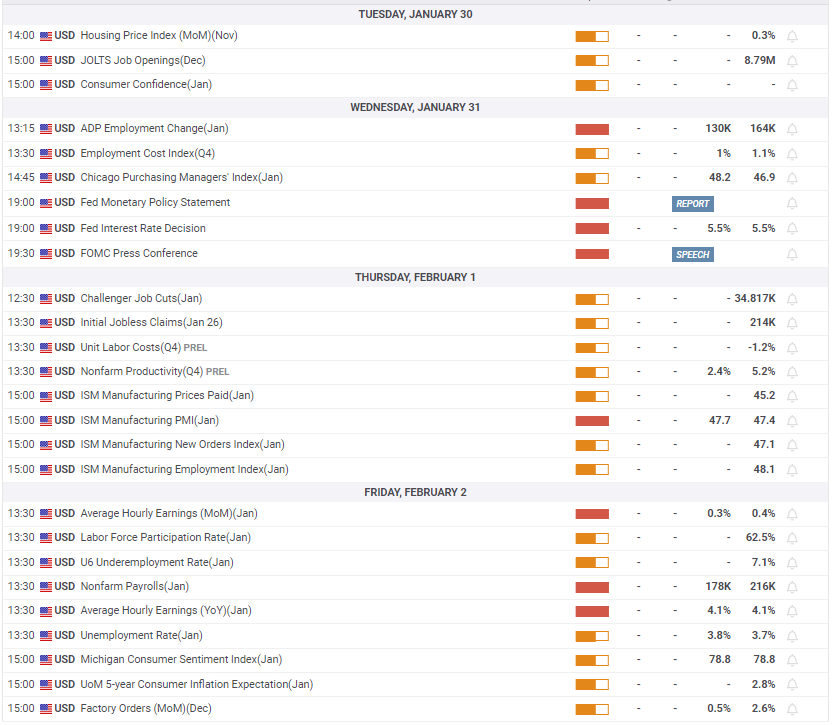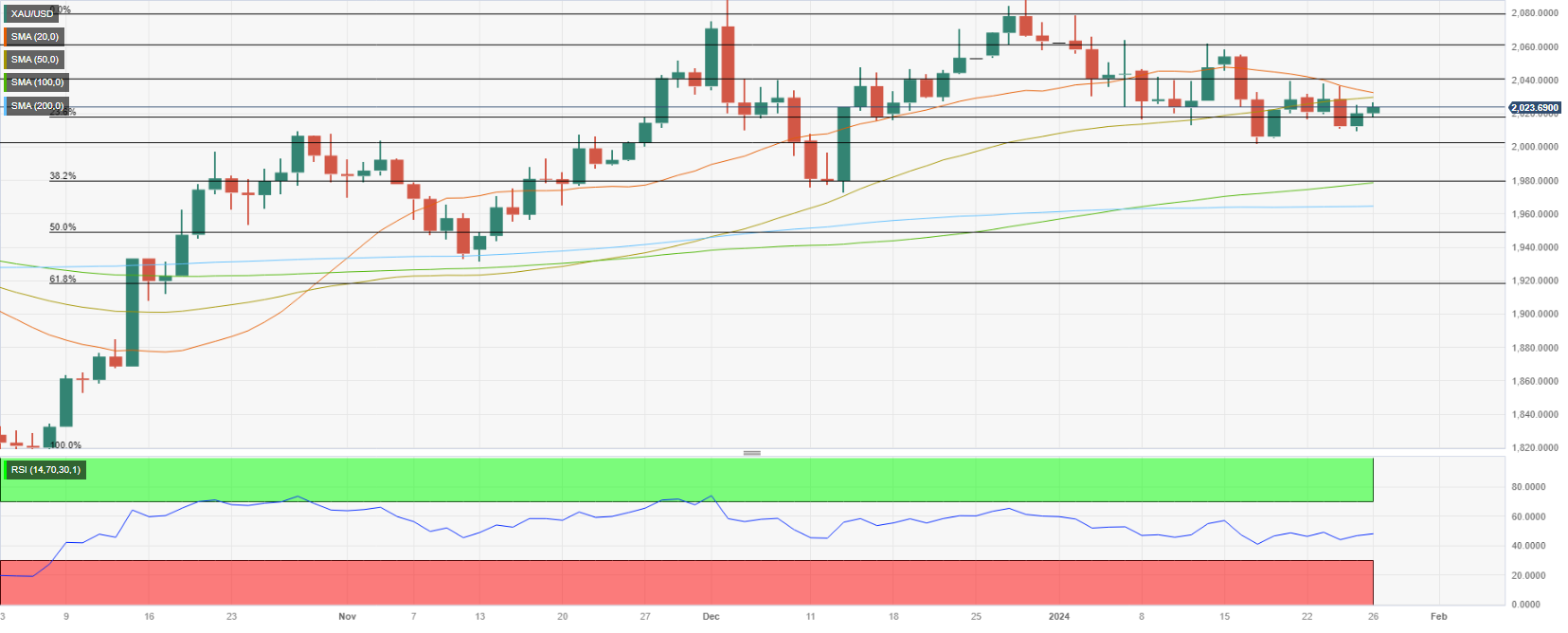- Gold continued to move up and down in a relatively tight range above $2,000.
- The near-term technical outlook highlights XAU/USD’s indecisiveness.
- Fed policy announcements and US jobs data will be watched closely by investors next week.
Gold struggled to find direction and closed the week little changed. Although the US Dollar (USD) benefited from some upbeat data releases, escalating geopolitical tensions helped XAU/USD hold its ground. The Federal Reserve’s (Fed) first policy meeting of the year and January jobs data from the US could significantly impact Gold’s valuation next week.
Gold price moved sideways this week
Gold edged higher to start the week as the improving risk mood made it difficult for the USD to find demand in the absence of high-tier data releases. A Bloomberg report claiming that China was considering an equity market rescue package worth about 27 billion USD triggered a rally in global equity indexes.
On Tuesday, Gold failed to build on Monday’s gains, while the benchmark 10-year US Treasury bond yield held steady above 4%. S&P Global PMI data showed on Wednesday that the business activity in the US private sector expanded at an accelerating pace in January. S&P Global Composite PMI improved to 52.3 from 50.9 in December, Services PMI rose to 52.9 and Manufacturing PMI recovered above 50, pointing to an expansion in the manufacturing sector for the first time since April. In turn, the benchmark 10-year US Treasury bond yield edged higher, causing XAU/USD to drop to a weekly low below $2,020.
Commenting on the PMI report, “an encouraging start to the year is indicated for the US economy by the flash PMI data, with companies reporting a marked acceleration of growth alongside a sharp cooling of inflation pressures,” said Chris Williamson, Chief Business Economist at S&P Global Market Intelligence.
In the meantime, escalating geopolitical tensions helped Gold limit its losses. Iran-backed Houthi rebels in Yemen reportedly targeted two US-owned commercial ships sailing close to the Gulf of Aden late Wednesday.
The Bureau of Economic Analysis (BEA) reported on Thursday that the real Gross Domestic Product (GDP) of the US expanded at an annual rate of 3.3% in the fourth quarter, surpassing the market expectation for a 2% growth by a wide margin. Although the immediate market reaction to the upbeat GDP data provided a boost to the USD, retreating US yields allowed XAU/USD to find a foothold. Other US data showed that the weekly Initial Jobless Claims rose to 214,000 in the week ending January 20 from 189,000 in the previous week and Durable Goods Orders remained unchanged in December to miss the market expectation for a 1.1% increase. Moreover, GDP Price Index for the fourth quarter declined to 1.5% from 3.3% in Q3 and the Personal Consumption Expenditures (PCE) Price Index rose 2% on a quarterly basis, matching the third quarter’s increase.
On Friday, the BEA announced that inflation in the US, as measured by the change in Personal Consumption Expenditures (PCE) Price Index, held steady at 2.6% on a yearly basis in December. The annual Core PCE Price Index, the Fed’s preferred gauge of inflation, softened to 2.9% in the same period from 3.2% in November, coming in slightly below the market forecast of 3%. The USD struggled to gather strength after this report and allowed Gold to stabilize above $2,020.
Gold price faces key risk events next week
On Tuesday, December JOLTS Job Openings and the CB Consumer Confidence Index data for January will be featured in the US economic docket. Ahead of the Fed’s monetary policy announcements on Wednesday, however, investors are unlikely to take large positions based on these data.
The Fed is widely expected to leave the policy rate unchanged at 5.25%-5.5% following the first meeting of the year. According to CME FedWatch Tool, markets are pricing in a nearly 50% chance that there will be a 25 basis points rate cut in March. Ahead of the blackout period, several Fed policymakers pushed back against this expectation, helping the USD to stay resilient against its rivals and the benchmark 10-year yield to stabilize above 4%. In case the policy statement, or Chairman Jerome Powell at the press conference, clearly rules out a rate reduction in March, the market positioning suggests that there is room for further USD strength. On the other hand, a fresh USD sell-off could be seen if Powell leaves the door open for a rate cut at the next meeting. In this scenario, a sharp decline in the 10-year yield below the key 4% level could open the door for a decisive rally in XAU/USD. Participants will also pay close attention to comments on the inflation outlook amid growing concerns over energy prices rising on supply issues.
Later in the week, the Bureau of Labor Statistics will release January jobs report. Nonfarm Payrolls (NFP) are forecast to rise by 162,000 following the 216,000 increase recorded in December. In case the NFP arrives close to 200,000, markets could react to the Labor Force Participation Rate and wage inflation figures.
In December, the Labor Force Participation Rate dropped to 62.5% from 62.8% in November and made it difficult for the USD to capitalize on the upbeat NFP print. A rebound in this data could positively impact the USD.
Wage inflation, as measured by the change in Average Hourly Earnings, is seen rising 0.3% on a monthly basis in January. A weaker-than-forecast print could make it difficult for the USD to outperform its rivals even if other details point to loosening conditions in the labor market.


Gold technical outlook
The near-term technical outlook highlights a lack of directional momentum, with the Relative Strength Index (RSI) indicator on the daily chart moving sideways near 50.
On the downside, $2,000 (psychological level, static level) aligns as a key support level. If XAU/USD falls below that level and starts using it as resistance, technical sellers could take action and open the door for an extended slide toward $1,980 and $1,960, where the 100- and 200-day Simple Moving Averages (SMA) are located.
Looking north, first resistance seems to have formed at $2,030 (20-day SMA, 50-day SMA) ahead of $2,040 (static level). A daily close above the latter could attract buyers and trigger a leg higher toward $2,060 (static level).






